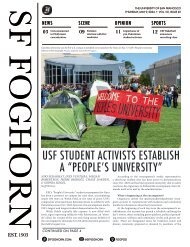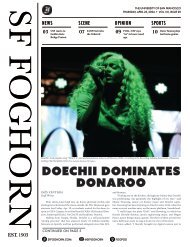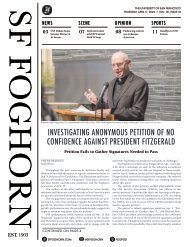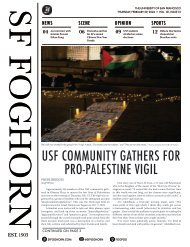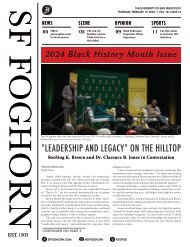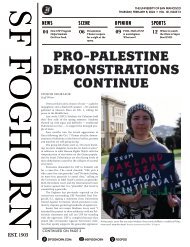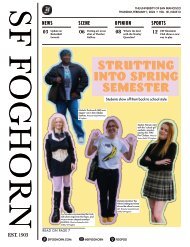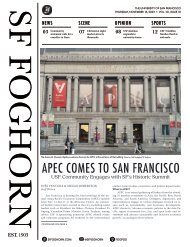You also want an ePaper? Increase the reach of your titles
YUMPU automatically turns print PDFs into web optimized ePapers that Google loves.
02 03<br />
THURSDAY<br />
APR. 18<br />
2024<br />
SAN FRANCISCO<br />
FOGHORN<br />
Freedom and Fairness<br />
STAFF EDITORIAL<br />
CONTINUED FROM FRONT PAGE<br />
STAFF<br />
Editor in Chief<br />
MEGAN ROBERTSON<br />
mrrobertson2@dons.usfca.edu<br />
News Editor<br />
NIKI SEDAGHAT<br />
nisedaghat@dons.usfca.edu<br />
Opinion Editor<br />
CHISOM OKORAFOR<br />
cokorafor@dons.usfca.edu<br />
Scene Editor<br />
INÉS VENTURA<br />
ipventura@dons.usfca.edu<br />
Sports Editor<br />
CHASE DARDEN<br />
cbdarden@dons.usfca.edu<br />
Photography Editor<br />
SAMANTHA AVILA GRIFFIN<br />
svavilagriffin@dons.usfca.edu<br />
General Reporter<br />
PHEBE BRIDGES<br />
pjbridges@dons.usfca.edu<br />
General Reporter<br />
ELINA GRAHAM<br />
emgraham@dons.usfca.edu<br />
415.422.5444<br />
sffoghorn.com<br />
SUBMISSION POLICY<br />
The San Francisco Foghorn is the<br />
official student newspaper of the<br />
University of San Francisco and<br />
is sponsored by the Associated<br />
Students of the University of San<br />
Francisco (ASUSF).<br />
The thoughts and opinions<br />
expressed herein are those of the<br />
individual writers and do not<br />
necessarily reflect those of the<br />
Foghorn staff, the administration,<br />
the faculty, staff or the students of<br />
the University of San Francisco.<br />
Contents of each <strong>issue</strong> are the sole<br />
responsibilities of the editors.<br />
An All-American<br />
Publication<br />
ad maiorem dei<br />
gloriam<br />
The San Francisco Foghorn is free<br />
of charge.<br />
Advertising matter printed herein<br />
is solely for informational purposes.<br />
Such printing is not to be construed<br />
as written or implied sponsorship<br />
or endorsement of such commercial<br />
enterprises or ventures by the San<br />
Francisco Foghorn.<br />
©MMIV-MMV, San Francisco<br />
Foghorn. All rights reserved. No<br />
material printed herein may be reproduced<br />
without prior permission<br />
of the Editor in Chief.<br />
Managing Editor<br />
JORDAN PREMMER<br />
jepremmer@dons.usfca.edu<br />
Copy Editor<br />
SOPHIA SIEGEL<br />
scsiegel@dons.usfca.edu<br />
Layout Editor<br />
ANYA JORDAN<br />
arjordan@dons.usfca.edu<br />
Layout Editor<br />
HALLEY COMPUTESTO<br />
hmcompuesto@dons.usfca.edu<br />
Social Media Manager<br />
MARIA ZAIED<br />
mfzaied@dons.usfca.edu<br />
Online Editor<br />
ESHA DUPUGUNTLA<br />
ekdupuguntla@dons.usfca.edu<br />
ADVISOR<br />
TERESA MOORE<br />
2130 FULTON STREET, UC #417<br />
SAN FRANCISCO, CA 94117<br />
Columns for the Opinion section<br />
and Letters to the Editor are gladly<br />
accepted from students, faculty, staff<br />
and alumni.<br />
All materials must be signed and<br />
include your printed name, university<br />
status (class standing or title),<br />
address, and telephone number for<br />
verification. Anonymous submissions<br />
are not published.<br />
We reserve the right to edit materials<br />
submitted. All submissions<br />
become the property of the San<br />
Francisco Foghorn.<br />
Staff editorials are written by the<br />
Foghorn editorial staff and represent<br />
a group consensus.<br />
The San Francisco Foghorn Opinion<br />
page is a forum for the free, fair and<br />
civil exchange of ideas. Contributors’<br />
opinions are not meant to<br />
reflect the views of the Foghorn staff<br />
or the University of San Francisco.<br />
Students interested in contributing<br />
to the Foghorn can scan and fill out<br />
the QR code below.<br />
ECO-CIDE: HOW WAR WEAPONIZES THE ENVIRONMENT<br />
The environment has become<br />
a casualty of war. International law<br />
needs to catch up to this reality and<br />
address it.<br />
According to the World Economic<br />
Forum, ecocide means “unlawful or<br />
wanton acts committed with knowledge<br />
that there is a substantial likelihood<br />
of severe and either widespread<br />
or long-term damage to the environment<br />
being caused by those acts.” For<br />
example, companies dumping pollutants<br />
in waterways or cutting down<br />
entire forests would qualify.<br />
Though the word is relatively<br />
new, a handful of countries already<br />
consider it a crime. The Foghorn believes<br />
a more specific crime must be<br />
articulated: the crime of intentional<br />
and malicious destruction of land to<br />
render it uninhabitable for the population.<br />
In this way, the environment<br />
is leveraged as a weapon of warfare.<br />
For example, in Dec. 2023, the Israeli<br />
Defense Forces announced that<br />
they began pumping seawater into<br />
the tunnels under the Gaza strip. Beyond<br />
being a danger to any humans in<br />
those tunnels - such as Israelis being<br />
held by Hamas - an article by Scientific<br />
American details the potential<br />
environmental devastation of such an<br />
act. The seawater could contaminate<br />
the aquifer underneath Gaza, which<br />
the strip’s millions of residents rely<br />
for drinking, agriculture, and sanitization.<br />
United Nations (UN) experts<br />
warned the action could render the<br />
land uninhabitable. Furthermore,<br />
though Israeli officials claimed the<br />
move was to destroy Hamas’ militant<br />
capabilities, many argue the move<br />
is just another effort to ethnically<br />
cleanse Palestinians in Gaza from the<br />
land. If true, pumping seawater into<br />
Gaza’s grounds could be a violation of<br />
the UN’s Genocide Convention.<br />
A Human Rights Watch investigation<br />
in Oct. 2023 found that Israel<br />
also dropped white phosphorus on<br />
Gaza and parts of southern Lebanon<br />
— particularly agricultural areas.<br />
White phosphorus is an extremely incendiary<br />
chemical that ignites upon<br />
making contact with oxygen. When<br />
deployed, it is devastating to humans<br />
and nature alike. In Lebanon, white<br />
phosphorus scorched olive and citrus<br />
orchards to the ground and possibly<br />
have left the targeted land unusable<br />
for agriculture for years. This move<br />
violates the right of Lebanese people<br />
to an environment that can sustain<br />
them. Israel’s use of the chemical<br />
weapon has been decried as illegal<br />
under international norms.<br />
However, Israel is not the first<br />
country to weaponize the environment<br />
against their adversaries. There<br />
is a long history of forcing indigenous<br />
people off their lands via environmental<br />
destruction.<br />
In the <strong>19</strong>th century, the United<br />
States carried out a massacre of<br />
bison. This slaughter irreparably<br />
changed the landscape of the Great<br />
Plains east of the Rocky Mountains.<br />
Furthermore, South Dakota State<br />
University found that these killings<br />
were organized as a military strategy<br />
in the colonial project against the<br />
indigenous people to make their land<br />
uninhabitable.<br />
The environment was weaponized<br />
during the Civil War, with General<br />
William Sherman’s scorchedearth<br />
March to the Sea. It pops up in<br />
Vietnam, when U.S. troops deployed<br />
Agent Orange against rice farmland.<br />
The war crime of environmental<br />
destruction exists — we’ve seen<br />
it committed. Even so, international<br />
law hasn’t caught on. Though these<br />
acts clearly meet the conditions for<br />
Genocide under the Convention,<br />
which make it illegal to “Deliberately<br />
inflict… on the group conditions of<br />
life calculated to bring about its physical<br />
destruction in whole or in part,”<br />
we haven’t seen world leaders willing<br />
to vocalize this crime.<br />
Until we have the specific terminology<br />
to refer to the intentional weaponizing<br />
of the environment against<br />
its inhabitants, we are doomed to<br />
watch this crime be perpetrated over<br />
and over again.<br />
CORRECTIONS BOX<br />
In our Apr. 11 article, “USF Discontinues Tennis Programs,” we stated<br />
that the email announcing the program’s termination was sent to USF<br />
community members on Apr. 9. It was sent on Apr. 5.<br />
earth month spotlight<br />
BREAKING DOWN THE BUDGET<br />
revenue comes from tuition, a statistic which is<br />
provided by UBAC in their presentation, hyperlinked<br />
in the online edition of this article. Making<br />
up the rest of the budget, 8% is from auxiliary<br />
revenue, 2.2% is meal plan revenue, 1.2% is investment<br />
returns, .7% revenue is from fees, .5% is other<br />
revenue, and .3% is from gifts and contributions.<br />
“Auxiliary revenue includes things like room and<br />
board, as well as Koret,” specified Sholes. Also<br />
noted is the approximate $50 million received as<br />
restricted gifts, wherein the donors require their<br />
donations to go to a specific cause. Most frequently,<br />
this money goes towards scholarships and endowments.<br />
The total revenue for the 2024 fiscal<br />
year is $5<strong>19</strong>.8 million.<br />
Nkemere said, “Almost 100% of our school’s<br />
revenue is spent with the exception of about 3% in<br />
savings reserves.” According to the presentation,<br />
USF has $5<strong>19</strong>.8 million in total expenses for this<br />
2024 fiscal year.<br />
27% of the revenue is spent on academic affairs.<br />
“This is to pay salary for staff for those specific<br />
colleges themselves,” said Nkemere.<br />
courtesy of UBAC.<br />
35.8% of this revenue is spent on “other academic<br />
affairs.” “The other category is basically<br />
classified by all the money that’s spent that’s not directly in the academic<br />
schools themselves,” said Nkemere. “So, something that would<br />
be encompassed in this portion itself would be about $135 million in<br />
scholarships paid to students for this fiscal year.”<br />
Additionally, according to the presentation, 15.1% of the operating<br />
expenses goes to business and finances, 6.8% goes to student life,<br />
4.9% goes to ITS, 3.7% goes to athletics, 2.7% goes to institutional<br />
support, 2% goes toward development, 1% goes to the Office of Marketing<br />
Communications, .6% goes to general council, and .3% goes to<br />
the President.<br />
The percentages provided for both the revenue and expenses respectively<br />
add up to 99.9%.<br />
Pictured above are the University’s 2024 expenses, which is all the money slated to be spent this fiscal year.<br />
Graphic courtesy of UBAC.<br />
Pictured above are the University’s 2024 revenue, which is all the money collected this fiscal year. Graphic<br />
After the presentation was complete, the ASUSF Senate opened<br />
the floor for student questions, which were answered by members of<br />
the senate, alongside some administrative members of UBAC and faculty<br />
members.<br />
Students and community members asked questions pertaining to<br />
the budget and financial plans for the university. Some students, however,<br />
found the answers to be somewhat underwhelming.<br />
“I think [the faculty members] answered the questions, but… they<br />
didn’t give any hard answers, and they didn’t really make any concrete<br />
assurances to the audience,” said Getchell. “But, walking out, I did<br />
feel much more confident in our school’s organization…It probably<br />
lowered my anxiety a little bit about raising tuition.”<br />
For the 2024-2025 school year, USF announced that tuition will<br />
be raised by 3.9%, or $2,250 according to the presentation.<br />
In regards to tuition increases, Sholes<br />
said,“UBAC does not have any <strong>final</strong> decision [on<br />
tuition increases]. When [UBAC members vote],<br />
their votes are recommendations that then go to<br />
the higher ups… and that’s when the <strong>final</strong> decision<br />
is made.”<br />
After the town hall, Sholes told the Foghorn,<br />
“it was definitely nerve wracking leading up to [the<br />
town hall] because we both wanted to do a good<br />
job. It’s a bit of a difficult situation… we’re students<br />
but we also play a role in UBAC. I think overall it<br />
went well, I think a lot of the questions were really<br />
great and very thoughtful.”<br />
She continued, saying “I was really happy with<br />
how open everything was. There’s just, overall,<br />
hope that this is something that can continue every<br />
year, which I think is really positive.”<br />
Editor-in-Chief: Megan Robertson, Chief Copy<br />
Editor: Sophia Siegel, Managing Editor: Jordan<br />
Premmer, News Editor: Niki Sedaghat<br />
NEWS




